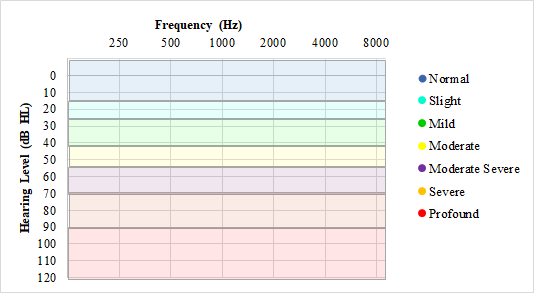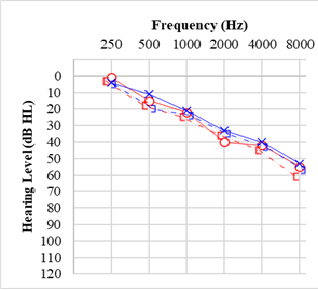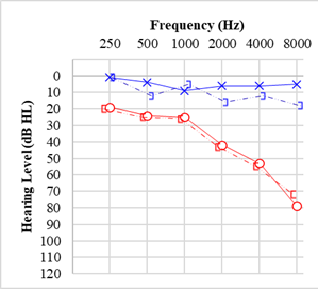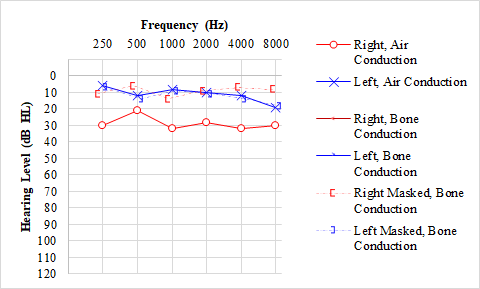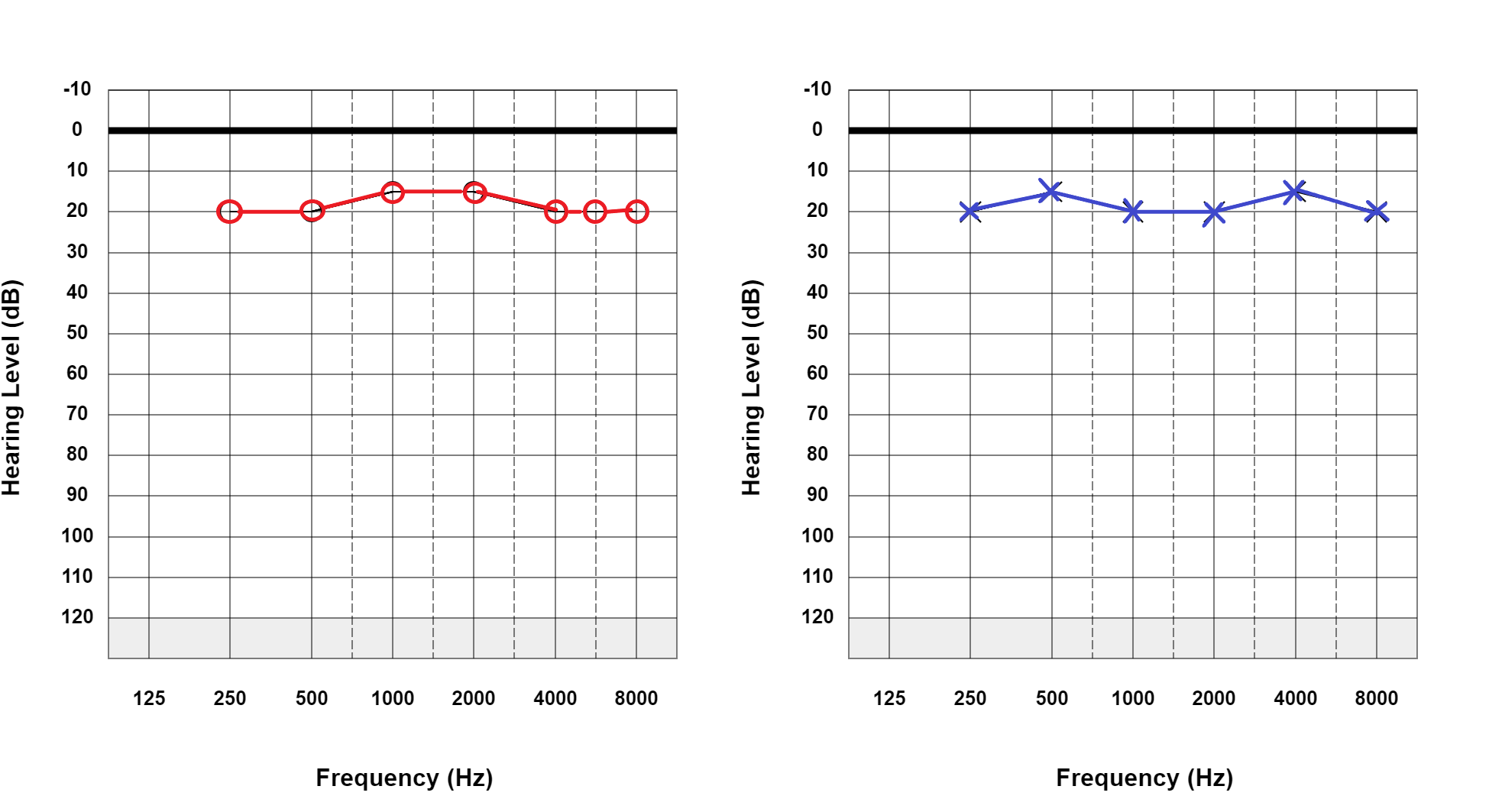[2]
Goman AM, Lin FR. Prevalence of Hearing Loss by Severity in the United States. American journal of public health. 2016 Oct:106(10):1820-2. doi: 10.2105/AJPH.2016.303299. Epub 2016 Aug 23
[PubMed PMID: 27552261]
[3]
Mahboubi H,Lin HW,Bhattacharyya N, Prevalence, Characteristics, and Treatment Patterns of Hearing Difficulty in the United States. JAMA otolaryngology-- head
[PubMed PMID: 29167904]
[4]
Chole RA,Cook GB, The Rinne test for conductive deafness. A critical reappraisal. Archives of otolaryngology--head & neck surgery. 1988 Apr
[PubMed PMID: 3348896]
[5]
Kelly EA, Li B, Adams ME. Diagnostic Accuracy of Tuning Fork Tests for Hearing Loss: A Systematic Review. Otolaryngology--head and neck surgery : official journal of American Academy of Otolaryngology-Head and Neck Surgery. 2018 Aug:159(2):220-230. doi: 10.1177/0194599818770405. Epub 2018 Apr 17
[PubMed PMID: 29661046]
Level 1 (high-level) evidence
[6]
Musiek FE,Shinn J,Chermak GD,Bamiou DE, Perspectives on the Pure-Tone Audiogram. Journal of the American Academy of Audiology. 2017 Jul/Aug;
[PubMed PMID: 28722648]
Level 3 (low-level) evidence
[8]
Michels TC,Duffy MT,Rogers DJ, Hearing Loss in Adults: Differential Diagnosis and Treatment. American family physician. 2019 Jul 15;
[PubMed PMID: 31305044]
[9]
Castellucci A,Piras G,Del Vecchio V,Crocetta FM,Maiolo V,Ferri GG,Ghidini A,Brandolini C, The effect of superior canal dehiscence size and location on audiometric measurements, vestibular-evoked myogenic potentials and video-head impulse testing. European archives of oto-rhino-laryngology : official journal of the European Federation of Oto-Rhino-Laryngological Societies (EUFOS) : affiliated with the German Society for Oto-Rhino-Laryngology - Head and Neck Surgery. 2021 Apr;
[PubMed PMID: 32592013]
[10]
Saunders AZ,Stein AV,Shuster NL,Walker HK,Hall WD,Hurst JW, Audiometry Clinical Methods: The History, Physical, and Laboratory Examinations. 1990;
[PubMed PMID: 21250083]
[11]
Douniadakis DE,Kalli KI,Psarommatis IM,Tsakanikos MD,Apostolopoulos NK, Incidence of hearing loss among children presented with speech-language delay. Scandinavian audiology. Supplementum. 2001;
[PubMed PMID: 11318469]
[12]
Casazza G,Meier JD, Evaluation and management of syndromic congenital hearing loss. Current opinion in otolaryngology
[PubMed PMID: 28697000]
Level 3 (low-level) evidence
[13]
Trudeau S,Anne S,Otteson T,Hopkins B,Georgopoulos R,Wentland C, Diagnosis and patterns of hearing loss in children with severe developmental delay. American journal of otolaryngology. 2021 May-Jun
[PubMed PMID: 33486206]
[15]
Suppiej A,Rizzardi E,Zanardo V,Franzoi M,Ermani M,Orzan E, Reliability of hearing screening in high-risk neonates: comparative study of otoacoustic emission, automated and conventional auditory brainstem response. Clinical neurophysiology : official journal of the International Federation of Clinical Neurophysiology. 2007 Apr;
[PubMed PMID: 17317296]
Level 2 (mid-level) evidence
[16]
Maclennan-Smith F,Swanepoel de W,Hall JW 3rd, Validity of diagnostic pure-tone audiometry without a sound-treated environment in older adults. International journal of audiology. 2013 Feb
[PubMed PMID: 23140522]
[17]
Luks SB,Borton TE,Nolen BL, Insert earphones for audiometry: applications, advantages, and limitations. ENTechnology. 1989 Sep;
[PubMed PMID: 2692634]
[18]
Valente M,Valente M,Goebel J, High-frequency thresholds: circumaural earphone versus insert earphone. Journal of the American Academy of Audiology. 1992 Nov;
[PubMed PMID: 1486204]
[19]
Walker G,Dillon H,Byrne D, Sound field audiometry: recommended stimuli and procedures. Ear and hearing. 1984 Jan-Feb
[PubMed PMID: 6706021]
[21]
Tharpe AM,Bess FH,Sladen DP,Schissel H,Couch S,Schery T, Auditory characteristics of children with autism. Ear and hearing. 2006 Aug
[PubMed PMID: 16825892]
[22]
Nightengale EE,Wolter-Warmerdam K,Yoon PJ,Daniels D,Hickey F, Behavioral Audiology Procedures in Children With Down Syndrome. American journal of audiology. 2020 Sep 3;
[PubMed PMID: 32539476]
[23]
Walker JJ,Cleveland LM,Davis JL,Seales JS, Audiometry screening and interpretation. American family physician. 2013 Jan 1;
[PubMed PMID: 23317024]
[24]
Halloran DR,Hardin JM,Wall TC, Validity of pure-tone hearing screening at well-child visits. Archives of pediatrics & adolescent medicine. 2009 Feb
[PubMed PMID: 19188648]
[26]
Abu-Eta R,Gavriel H,Pitaro J, Extended High Frequency Audiometry for Revealing Sudden Sensory Neural Hearing Loss in Acute Tinnitus Patients. International archives of otorhinolaryngology. 2021 Jul
[PubMed PMID: 34377177]
[27]
Ganesan P, Schmiedge J, Manchaiah V, Swapna S, Dhandayutham S, Kothandaraman PP. Ototoxicity: A Challenge in Diagnosis and Treatment. Journal of audiology & otology. 2018 Apr:22(2):59-68. doi: 10.7874/jao.2017.00360. Epub 2018 Feb 26
[PubMed PMID: 29471610]
[28]
Fabijańska A,Smurzyński J,Hatzopoulos S,Kochanek K,Bartnik G,Raj-Koziak D,Mazzoli M,Skarżyński PH,Jędrzejczak WW,Szkiełkowska A,Skarżyński H, The relationship between distortion product otoacoustic emissions and extended high-frequency audiometry in tinnitus patients. Part 1: normally hearing patients with unilateral tinnitus. Medical science monitor : international medical journal of experimental and clinical research. 2012 Dec;
[PubMed PMID: 23197241]
[29]
Poling GL,Kunnel TJ,Dhar S, Comparing the Accuracy and Speed of Manual and Tracking Methods of Measuring Hearing Thresholds. Ear and hearing. 2016 Sep-Oct
[PubMed PMID: 27232075]
[30]
Cone BK,Wake M,Tobin S,Poulakis Z,Rickards FW, Slight-mild sensorineural hearing loss in children: audiometric, clinical, and risk factor profiles. Ear and hearing. 2010 Apr
[PubMed PMID: 20054279]
[31]
Ontario Health (Quality) ., Implantable Devices for Single-Sided Deafness and Conductive or Mixed Hearing Loss: A Health Technology Assessment. Ontario health technology assessment series. 2020
[PubMed PMID: 32194878]
Level 2 (mid-level) evidence
[33]
Gumus NM,Gumus M,Unsal S,Yuksel M,Gunduz M, Examination of Insert Ear Interaural Attenuation (IA)Values in Audiological Evaluations. Clinical and investigative medicine. Medecine clinique et experimentale. 2016 Dec 1;
[PubMed PMID: 27917798]
[34]
Recommendations for masking in pure tone threshold audiometry. British Society of Audiology. British journal of audiology. 1986 Nov
[PubMed PMID: 3790774]
[35]
Beahan N,Kei J,Driscoll C,Charles B,Khan A, High-frequency pure-tone audiometry in children: a test-retest reliability study relative to ototoxic criteria. Ear and hearing. 2012 Jan-Feb;
[PubMed PMID: 21760512]
[36]
Seneviratne S,McNeill C,Greenberg SL,Kong J, Naunton's Masking Dilemma Revisited. Otology & neurotology : official publication of the American Otological Society, American Neurotology Society [and] European Academy of Otology and Neurotology. 2019 Jan
[PubMed PMID: 30531635]
[37]
Lenhardt ML,Goldstein BA,Shulman A, Binaural hearing, atresia, and the masking dilemma. The international tinnitus journal. 2006
[PubMed PMID: 17260874]
[38]
Randolph LJ,Schow RL, Threshold inaccuracies in an elderly clinical population: ear canal collapse as a possible cause. Journal of speech and hearing research. 1983 Mar;
[PubMed PMID: 6865382]
[39]
Clemis JD,Ballad WJ,Killion MC, Clinical use of an insert earphone. The Annals of otology, rhinology, and laryngology. 1986 Sep-Oct;
[PubMed PMID: 3767222]
[40]
Tokar-Prejna S,Meinzen-Derr J, Relationship between transducer type and low-frequency hearing loss for patients with ventilation tubes. International journal of pediatric otorhinolaryngology. 2006 Jun;
[PubMed PMID: 16364457]
[41]
Schmidt CM,Am Zehnhoff-Dinnesen A,Deuster D, [Nonorganic (functional) hearing loss in children]. HNO. 2013 Feb;
[PubMed PMID: 22534679]
[42]
Durmaz A,Karahatay S,Satar B,Birkent H,Hidir Y, Efficiency of Stenger test in confirming profound, unilateral pseudohypacusis. The Journal of laryngology and otology. 2009 Aug
[PubMed PMID: 19296863]
[43]
Arslan HH,Edizer DT,Cebeci S,Erdal M, Diagnostic utility of Stenger test: reappraisal of its value. The international tinnitus journal. 2014;
[PubMed PMID: 27186834]
[44]
Stachler RJ,Chandrasekhar SS,Archer SM,Rosenfeld RM,Schwartz SR,Barrs DM,Brown SR,Fife TD,Ford P,Ganiats TG,Hollingsworth DB,Lewandowski CA,Montano JJ,Saunders JE,Tucci DL,Valente M,Warren BE,Yaremchuk KL,Robertson PJ,American Academy of Otolaryngology-Head and Neck Surgery., Clinical practice guideline: sudden hearing loss. Otolaryngology--head and neck surgery : official journal of American Academy of Otolaryngology-Head and Neck Surgery. 2012 Mar;
[PubMed PMID: 22383545]
Level 1 (high-level) evidence
[45]
Skarżyńska MB,Kołodziejak A,Gos E,Sanfis MD,Skarżyński PH, Effectiveness of Various Treatments for Sudden Sensorineural Hearing Loss-A Retrospective Study. Life (Basel, Switzerland). 2022 Jan 10;
[PubMed PMID: 35054488]
Level 2 (mid-level) evidence
[46]
Lane CL,Dobie RA,Crawford DR,Morgan MS, Standard threshold shift criteria. An investigation of the most reliable indicator of noise-induced hearing loss. Journal of occupational medicine. : official publication of the Industrial Medical Association. 1985 Jan;
[PubMed PMID: 3968596]
[47]
Schlauch RS,Carney E, A multinomial model for identifying significant pure-tone threshold shifts. Journal of speech, language, and hearing research : JSLHR. 2007 Dec;
[PubMed PMID: 18055764]
[48]
Durakovic N,Valente M,Goebel JA,Wick CC, What defines asymmetric sensorineural hearing loss? The Laryngoscope. 2019 May;
[PubMed PMID: 30408187]
[50]
Knobel KA,Sanchez TG, [Loudness discomfort level in normal hearing individuals]. Pro-fono : revista de atualizacao cientifica. 2006 Jan-Apr;
[PubMed PMID: 16625869]
[51]
Sherlock LP, Formby C. Estimates of loudness, loudness discomfort, and the auditory dynamic range: normative estimates, comparison of procedures, and test-retest reliability. Journal of the American Academy of Audiology. 2005 Feb:16(2):85-100
[PubMed PMID: 15807048]
[52]
Nascimento IDP,Almeida AA,Diniz J Junior,Martins ML,Freitas TMMWC,Rosa MRDD, Tinnitus evaluation: relationship between pitch matching and loudness, visual analog scale and tinnitus handicap inventory. Brazilian journal of otorhinolaryngology. 2019 Sep - Oct;
[PubMed PMID: 29983341]
[53]
Vermiglio AJ,Soli SD,Fang X, An Argument for Self-Report as a Reference Standard in Audiology. Journal of the American Academy of Audiology. 2018 Mar;
[PubMed PMID: 29488871]
[54]
Vermiglio AJ,Soli SD,Freed DJ,Fisher LM, The relationship between high-frequency pure-tone hearing loss, hearing in noise test (HINT) thresholds, and the articulation index. Journal of the American Academy of Audiology. 2012 Nov-Dec;
[PubMed PMID: 23169195]
[55]
Moore DR,Sieswerda SL,Grainger MM,Bowling A,Smith N,Perdew A,Eichert S,Alston S,Hilbert LW,Summers L,Lin L,Hunter LL, Referral and Diagnosis of Developmental Auditory Processing Disorder in a Large, United States Hospital-Based Audiology Service. Journal of the American Academy of Audiology. 2018 May
[PubMed PMID: 29708487]
[56]
Wei J,Hu Y,Zhang L,Hao Q,Yang R,Lu H,Zhang X,Chandrasekar EK, Hearing Impairment, Mild Cognitive Impairment, and Dementia: A Meta-Analysis of Cohort Studies. Dementia and geriatric cognitive disorders extra. 2017 Sep-Dec;
[PubMed PMID: 29430246]
Level 1 (high-level) evidence
[58]
Schönweiler R,Ptok M,Radü HJ, A cross-sectional study of speech- and language-abilities of children with normal hearing, mild fluctuating conductive hearing loss, or moderate to profound sensoneurinal hearing loss. International journal of pediatric otorhinolaryngology. 1998 Aug 1;
[PubMed PMID: 9780071]
Level 2 (mid-level) evidence
[59]
McClellan J,Nguyen A,Hamilton B,Jethanamest D,Hullar TE,Gupta S, Stapes Surgery Outcomes in Patients With Concurrent Otosclerosis and Superior Semicircular Canal Dehiscence. Otology
[PubMed PMID: 32472923]
[60]
Vlastarakos PV,Proikas K,Tavoulari E,Kikidis D,Maragoudakis P,Nikolopoulos TP, Efficacy assessment and complications of surgical management for superior semicircular canal dehiscence: a meta-analysis of published interventional studies. European archives of oto-rhino-laryngology : official journal of the European Federation of Oto-Rhino-Laryngological Societies (EUFOS) : affiliated with the German Society for Oto-Rhino-Laryngology - Head and Neck Surgery. 2009 Feb;
[PubMed PMID: 18953551]
Level 1 (high-level) evidence
[61]
Stevens SM,Walters ZA,Babo K,Peddireddy N,Tawfik KO,Samy RN, Canal reconstruction mastoidectomy: Outcomes comparison following primary versus secondary surgery. The Laryngoscope. 2019 Nov;
[PubMed PMID: 30883762]

